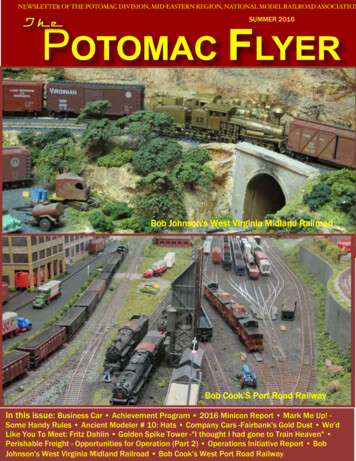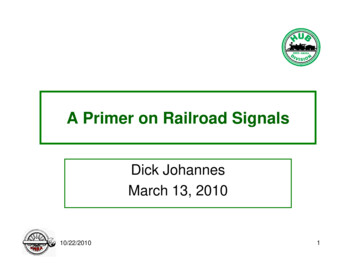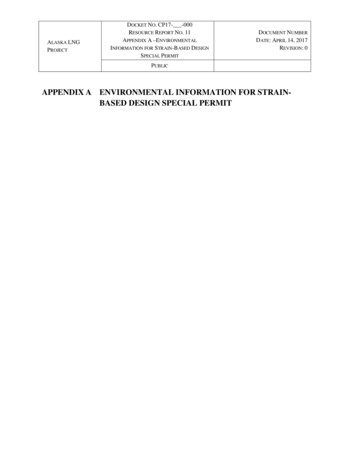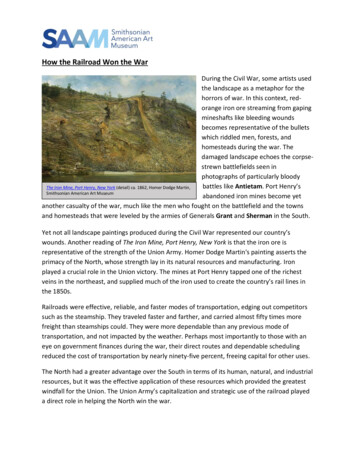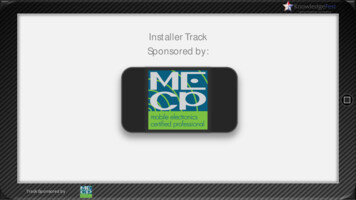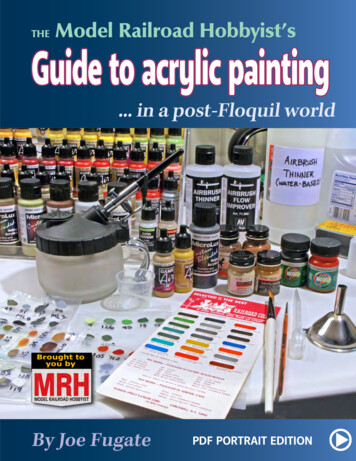
Transcription
THEModel Railroad Hobbyist’sGuide to acrylic painting. in a post-Floquil worldBy Joe FugatePDF PORTRAIT EDITION
(this page is intentionally blank)Page: 2MRH Guide to acrylic painting TABLE OF CONTENTS
THEModel Railroad Hobbyist’sGuide to acrylic painting. in a post-Floquil worldBy Joe FugatePhotos by Joe Fugate unless otherwise creditedMRHH AV I N G F U N W I T H T R A I N SMODEL RAILROAD HOBBYISTPage: 3Published by MRH Mediamrhmag.com TABLE OF CONTENTS
Copyright 2016 by MRH Media.All rights reserved. No part of this book may be reproduced in whole or in part without the written permission of the publisher except for brief excerpts used in reviews. Published by MRH Media, Woodburn, OR 97071.ISBN 978-1-942932-08-6First Edition, July 2016Republished with minor corrections, October 27, 2016Page: 4MRH Guide to acrylic painting TABLE OF CONTENTS
TABLE OF CONTENTSPREFACEICONS USED - IMPORTANT RESOURCE LINKS.CHAPTER 1: Criteria for choosing acrylic paintCHAPTER 2: Paint conversion chartCHAPTER 3: Acrylic mixing and storage tipsCHAPTER 4: Formulas for thinnersCHAPTER 5: Techniques for working with modern acrylics.SUMMATIONPage: 5Table of Contents TABLE OF CONTENTS
For decades, model railroaders considered Floquil and PollyScale paints to be the go-to paints for painting their models. Since Testors discontinued the line in 2013 and modelers’ paint stashes are now diminishing, it’s time to wean ourselves from these paints. Ideally, we can find 21st Century environmentallyfriendly replacements that are as good or better than these great old standbys.Page: 6MRH Guide to acrylic painting TABLE OF CONTENTS
PREFACEFloquil and the related acrylic PollyScale line were for many modelers the go-to paints for model railroading.But as we all know, Testors discontinued the Floquil/PollyScale line of paints in 2013.The hobby has good post-Floquil/PollyScale alternatives, but we need these replacement paints mapped backto familiar Floquil/PollyScale color equivalents to make getting weaned off these now-defunct paints easier.To that end, MRH has done two color-mapping projects, one for “acrylics” (defined as water-cleanup paints)and another for “lacquers and enamels” (defined as solvent-cleanup paints).This book discusses acrylics mapping. and our other book: The Model Railroad Hobbyist’s Guide to lacquerbased painting in a post-Floquil world covers solvent-based paints.If you prefer water-soluble pre-thinned model paints as I do, then I want to help you make an easy transitionin a post-Floquil world to painting with water-based acrylics. If you’ve been a staunch solvent paint user,acrylic paint has come a long way in the last couple decades, so maybe it’s time to revisit using acrylics nowthat Floquil is no more?To this end, I’ve included an extensive Floquil/PollyScale color translation chart for the leading acrylic paintsavailable for painting models.If colors translate one-to-one, I’ve listed that. I’ve also included formulas for colors that don’t translate one-toone. Plus I’ve included tips on mixing and storing these paints so they keep better.I’ve also included advice on how I do both brush painting and airbrush painting with acrylics.We hope you find this post-Floquil painting guide to be your new go-to guide for painting your models! Joe Fugate, MRHPage: 7Forward TABLE OF CONTENTS
ICONS USED IN THIS BOOKLETTo make the most important pointers in this book hard to miss, I’m using a couple icons.First, there’s the tip icon. This points out especially helpful nuggets of information, and may alsosummarize other nearby text. You won’t want to miss one of these, which is why I call them out soyou’ll see them!Then there’s the warning icon. This icon highlights a method or technique you can’t scrimp on or dopoorly, so pay close attention to the process to make sure you don’t mess it up! If you do happen to getit wrong, I’ll also point out how to fix it, if possible.IMPORTANT RESOURCE LINKS: OTHER GOODIES!This book is only a part of what you get with our post-Floquil painting guide booklets.Customers also get online access to more goodies to help you achieve a better model painting experience.Look for these additional resources:Cheat sheets: Remember the crib notes or “cheat sheet” you used to make in school to prepare for an exam?We take the key points in each booklet and distill them down into some cheat sheet summaries for you to keephandy and we post them online. URL: t-sheetsBonus chapters: Because we’re doing both a printed version and an eBook version of these booklets, we do havespace limitations to keep the cost down. Never fear, if it doesn’t fit, then we’re making it available for you onlinefor free as bonus chapters. URL: s-chaptersWeb links: We constantly browse the web for the best content on the topic of painting models. Much of theinformation is pretty basic, some is just plain wrong, some is okay but presentation sorely lacks, and there’s afew truly golden nuggets available online. We save you a lot of time by giving you the best links.URL: linksSupplemental videos: Some concepts can be difficult to explain and understand with just text and still photos. In these cases, we’re highlighting some short videos so you can see how it’s done.URL: osUpdates: Try as we might to get it right the first time, there are sure to be a few mistakes creep in. Plus hobbytechnology is constantly changing. For these instances, we’ll provide you with updates online.URL: tesRelated products: Yes, you may also get a few product-related emails from us on this topic of painting yourmodels better. One of the most frequent requests we get is for product insight. You can relax, we hate spamas much as you do. Anything we send on this topic will be infrequent, only from us directly, and will be killerlevel awesome or we won’t be bothering you.The way we think of it, as an MRH Subscriber, you become a subscriber to a literal library of resources forhelping you paint and finish your models better than ever. Page: 8MRH Guide to acrylic painting TABLE OF CONTENTS
To Vern, for investing in a teenage model railroader and instilling apassion for the hobby that still burns bright today.Page: 9Dedication TABLE OF CONTENTS
1-1. In looking for a suitable Floquil/PollyScale replacement paint, I considered the full gamut of paint usesfrom airbrush application, to brush painting, to thinning the paint and using it as a wash. Here, I’m applying a black water-based acrylic paint wash to an HO boxcar, bringing out the details by a technique I call“shadowing”. See chapter 5 for tips on working with acrylic paints and getting the most out of them.Page: 10MRH Guide to acrylic painting TABLE OF CONTENTS
CHAPTER 1CRITERIA FOR CHOOSING ACRYLIC PAINTIgave up using Floquil paints and moved to PollyScale water-based paints back in the 1990s. Floquil’ssolvents had an intense chemical-like odor and after I had a couple frightening episodes getting doublevision from Floquil solvent odor inhalation, I moved to PollyScale and its less problematic fumes.With the demise of Floquil/PollyScale, I have sought out a good replacement. My ideal replacement paintwould be:1. A low odor water-soluble acrylic paint that’s price competitive and available in a broad color line.2. Allows soap-and-water cleanup with no solvents needed.3. Pre-thinned for airbrushing, but usable as a brush paint for model details.4. (Optional) Color names expressed in railroad terms like the Floquil/PollyScale line.I found three excellent paints that fit my criteria #1 through #3: Badger’s MODELflex, Testors’ Model Master acrylics, and Vallejo Model Air/Game Air. Badger’s MODELflex also fits my criteria #4 with many colorsmapped to Floquil/PollyScale names. Testors has augmented sixteen of their Model Masters acrylic paint linewith the old PollyScale colors.Regarding criteria #4 for Model Air/Game Air, Micro-Mark selected ten of Vallejo’s Model Air paints and repackaged them into larger 60ml (2 oz.) craft paint flip-top bottles as MicroLux paint, color matched to PollyScale paint colors.Regarding price, Testors’ Model Master acrylic line comes pre-thinned for airbrushing, but most of theircolors need to be translated to railroad paint names to meet my criteria #4. Current list price, 3.69 per 0.5 oz[14.7ml] bottle.As for Badger’s MODELflex paint, I know many modelers who love the MODELflex line and I use them myselffor certain projects. Current list price, 4.25 per 1 oz [29.5ml] bottle.Model Air/Game Air currently lists at 3.30 per 0.6 oz [17 ml] bottle. MicroLux currently lists at 7.35 per 2 oz(59 ml) bottle.When we told Testors that MRH wanted to provide a color transition chart from their old Floquil / PollyScalepaint colors to their current Model Masters Acrylic line, Testors enthusiastically donated an entire set of theirModel Master paints to the project.Micro-Mark also donated their entire MicroLux paint line to MRH for the project too. MRH also acquired theentire Vallejo Model Air /Game Air paints line. Finally, MRH has Badger’s MODELflex paints in stock to docolor-for-color matching with them as we describe in the next chapter. Page: 11Chapter 1: Criteria for choosing TABLE OF CONTENTS
2-1. In this chapter I built a color-for-color paint conversion chart from Testors’ defunct Floquil / PollyScalepaints to the equivalent colors in the Testors Model Master, Vallejo Model Air/Game Air, and the BadgerMODELflex paint lines. To do this, MRH acquired an extensive collection of paints from each line and didpaint chip color matching back to the old Floquil / PollyScale colors. In some cases, there is no exact match,so I provide a mixing formula to get the same color. In a few cases, there is no color formula that works fora given brand and color. When that happens, then one of the other two brands does have a formula thatworks for that color.Page: 12MRH Guide to acrylic painting TABLE OF CONTENTS
CHAPTER 2PAINT CONVERSION CHARTTo help make the transition off Floquil/PollyScale paints, this chapter provides an extensive colormatching chart, color-for-color, for 72 of the old familiar colors. When the color is an exact match,then I give you that and life is good. If there is no exact match, then I list a mixing formula to getan exact match (also see Chapter 3 for mixing and storage tips). In a few cases, the specific color simplycan’t be mixed from other colors for a given paint brand. This is rare, but when that happens, the other twobrands can generally be used for that color.In some cases, the match was very close but not exact. When that happens, I often provide both the closematch and a formula for getting an exact match. In many cases, close will be good enough, especially if youplan to fade and weather the paint job on the final model.All three of these paint lines come pre-thinned for airbrushing, but they also can be brush painted with justa little care. For more on using these paints effectively, see Chapter 5: Techniques for working with modernacrylic paints.All of the Vallejo Model Air / Game Air colors have a flat finish, and all the Badger MODELflex paints have asemi-gloss finish. Model Master paints vary, some are flat, others are semi-gloss, and still others have a glossfinish. On the Model Master paints, I include a notation on the paints that have a semi-gloss and gloss finish.If there is no notation, then the Model Master paint has a flat finish.Because the Model Master paint line is intended mostly for painting military models (trucks, tanks, ships,and airplanes), the color line tends to have more subdued tones. This does mean in some cases, a brighter railroad color such as NYC Jade Green made with Testors Model Master paints is a much less intense, faded tone.The Vallejo Model Air paints, like the Model Master paints, tend to have more subdued miliary modeling colortones as well. However, Vallejo also now makes their Game Air colors (intended for fantasy figure modelers),which adds a lot of brighter tones to the collection. These brighter colors enable model railroaders to mix almost any railroad color they need. Vallejo’s Game Air paints are fully compatible with their Model Air paints.The Badger MODELFlex paints have many colors already mapped by name back to the Floquil / PollyScalepaints, which eases transitioning off Floquil or PollyScale paints. Badger also has other MODELFlex colorsthat are outside the model railroading line (automotive, marine, and military colors), so in some cases wehave drawn on those other non-model railroading MODELFlex colors to get a closer color match.The color swatches shown in the following chart are only approximate. Because of monitor color calibration variations and printing press ink variations, the colors in the chart only provide a facsimile of the actuallabeled paint color. Page: 13Chapter 2: Paint conversion chart TABLE OF CONTENTS
MRH’s Floquil / PollyScale Paint Equivalents Conversion Chart - 1Floquil - PollyScaleColor (approx.)Model MasterVallejo - MicroLuxMODELflexPrimer GrayMM 4762VMA 71.05016-12Engine BlackMM 4888ML 29008VMA 71.25116-01Steam PowerBlackMM 4795VMA 71.05716-448Oily BlackMM 4797VMA 71.02116-44*Weathered(Tarnished) BlackMM 4750ML 29022VMA 71.05416-05Reefer GrayMM 48861MM 4761VMA 71.04516-04Reefer WhiteMM 4873ML 29004VMA 71.00116-02Grimy BlackMM 4887ML 29002VMA 71.05516-03Caboose RedMM 48802MM 4633†Mix .1pt VMA 71.0031pt VMA 71.10216-08NotesMM: Mix 4633 with20% Model Master’sflat medium to get asemi-gloss paint* Indicates a close but not exact match. All MODELflex paint is a semigloss finish.Vallejo Model Air/Game Air, MicroLux, and Model Master paints flat finish unless marked: † Gloss finish. ‡ Semigloss finish.1 Model Master’s new Reefer Gray is a shade darker than the old PollyScale Reefer Gray.Color 4761 Dark Ghost Gray is a closer match to the old PollyScale color.2 Model Master’s new Caboose Red is a shade lighter than the old PollyScale Caboose Red.Color 4633 Stop Light Red (gloss finish) is a closer match to the old PollyScale color. Add 20% flat medium to get semi-gloss.Page: 14MRH Guide to acrylic painting TABLE OF CONTENTS
MRH’s Floquil / PollyScale Paint Equivalents Conversion Chart - 2Floquil - PollyScaleModel MasterVallejo - MicroLuxMODELflexMix .5pt MM 46094pt MM 4605VMA 71.03616-53Reefer OrangeMM 4682*VMA 71.08316-09Reefer YellowMM 4879VMA 71.07816-10Roof BrownMM 4884ML 29009VMA 71.24916-176Railroad TieBrownMM 4885ML 29003VMA 71.02913-1471Rail BrownMM 4708*ML 29001VMA 71.13916-175RustMM 4675ML 29005VMA 71.03716-172MM 4876VMA 71.045*Closer match .1pt VMA 71.1311pt VMA 71.13216-11*MM 4875ML 29007VMA 71.14316-92*Closer match .3pt 16-911pt 16-51TuscanConcreteAged ConcreteColor (approx.)Notes* Indicates a close but not exact match. All MODELflex paint is a semigloss finish.Vallejo Model Air/Game Air, MicroLux, and Model Master paints flat finish unless marked: † Gloss finish. ‡ Semigloss finish.1 Badger’s 13-147, FREAKflex Wooden Stake Brown is actually a great match for Railroad Tie Brown. FREAKflex is a brand ofpaint intended for painting fantasy miniatures, but the formulation is completely compatible with MODELflex.Page: 15Chapter 2: Paint conversion chart TABLE OF CONTENTS
MRH’s Floquil / PollyScale Paint Equivalents Conversion Chart - 3Floquil - PollyScaleModel MasterVallejo - MicroLuxMODELflexMM 4877VGA 72.76116-174MudMM 4812*VMA 71.075*Closer match .1pt VMA 71.0751pt VMA 71.14316-173DirtMM 4608VGA 72.76216-94*Aged (Antique)WhiteMM 4874VMA 71.132*16-06Boxcar RedMM 4881Mix .1pt VMA 71.0381pt VMA 71.105Mix .2pt 16-151pt 16-14Oxide RedMM 4882VGA 72.712*16-71*Depot BuffMM 4878Mix .3pt VMA 71.0332pt VMA 71.02716-81*Depot OliveMM 4734VMA 71.09416-91FoundationMM 4722VGA 72.734*16-30*EarthColor (approx.)Notes* Indicates a close but not exact match. All MODELflex paint is a semigloss finish.Vallejo Model Air/Game Air, MicroLux, and Model Master paints flat finish unless marked: † Gloss finish. ‡ Semigloss finish.Page: 16MRH Guide to acrylic painting TABLE OF CONTENTS
MRH’s Floquil / PollyScale Paint Equivalents Conversion Chart - 4Floquil - PollyScaleModel MasterVallejo - MicroLuxMODELflexMM 4729*VMA 71.09316-192*Light GreenMM 4852VMA 71.126*Closer match .5pt VMA 71.1261pt VMA 71.00116-47Pullman GreenMM 4784VMA 71.01916-180Coach GreenMM 4726VMA 71.01716-164*Signal GreenMM 4883Mix .2pt VMA 71.0941pt VMA 71.11316-203Penn CentralGreenMix .3pt MM 48832pt MM 4863Mix .2pt VMA 71.0072pt VMA 71.0081pt VGA 72.72316-90BN GreenMix .4pt MM 47981pt MM 47221pt MM 4669Mix .5pt VMA 71.0941pt VMA 71.0891pt VMA 71.09516-26GN EmpireGreenMM 4849VMA 71.01816-65GN EmpireOrangeMix .2pt MM 48511pt MM 4880VMA 71.13016-64Dark GreenColor (approx.)Notes* Indicates a close but not exact match. All MODELflex paint is a semigloss finish.Vallejo Model Air/Game Air, MicroLux, and Model Master paints flat finish unless marked: † Gloss finish. ‡ Semigloss finish.Page: 17Chapter 2: Paint conversion chart TABLE OF CONTENTS
MRH’s Floquil / PollyScale Paint Equivalents Conversion Chart - 5Floquil - PollyScaleModel MasterVallejo - MicroLuxMODELflexDark BlueMM 4742VMA 71.09016-69*Light BlueMix .1pt MM 47421pt MM 4748VMA 71.111*16-93*GN Big Sky BlueMix .1pt MM 47424pt MM 4748Mix .4pt VMA 71.1083pt VGA 72.7231pt VGA 72.72216-63SP Lettering GreyMix .3pt MM 47621pt MM 4765VMA 71.12116-39SP Lark Lt GreyMM 4886VMA 71.12816-35SP Lark Dk GreyMM 4752VMA 71.04816-40Mix .6pt MM 47712pt MM 48511pt MM 4682Mix .4pt VMA 71.1301pt VMA 71.07416-38SP DaylightOrangeSP Daylight RedSP ScarletColor (approx.)MM 4631†MM 4629†VMA 71.086VMA 71.003Notes16-36MM: Mix 4631 with20% Model Master’sflat medium to get asemi-gloss paint16-37MM: Mix 4629 with20% Model Master’sflat medium to get asemi-gloss paint* Indicates a close but not exact match. All MODELflex paint is a semigloss finish.Vallejo Model Air/Game Air, MicroLux, and Model Master paints flat finish unless marked: † Gloss finish. ‡ Semigloss finish.Page: 18MRH Guide to acrylic painting TABLE OF CONTENTS
MRH’s Floquil / PollyScale Paint Equivalents Conversion Chart - 6Floquil - PollyScaleModel MasterVallejo - MicroLuxMODELflexAmtrak BlueMix .2pt MM 47421pt MM 4866Mix .5pt VMA 71.1111pt VGA 72.7211pt VGA 72.72216-59Amtrak RedMix .1pt MM 46331pt MM 4629†VGA 72.71016-58UP ArmourYellowMix .6pt MM 46831pt MM 4879VMA 71.033*Closer match .5pt VMA 71.0331pt VMA 71.00116-24MM 4866*Closer match .3pt MM 48662pt MM 4759Mix .5pt VMA 71.1201pt VMA 71.11516-25TTX YellowMM 4611VGA 72.70516-168Railbox YellowMM 4684VGA 72.70616-54CSX GreyMM 4886VMA 71.05116-70CSX BlueMix .2pt MM 47421pt MM 4840Mix .5pt VMA 71.0871pt VMA 71.10816-49MM 4684*VGA 72.706*16-50UP Harbor MistGrayCSX YellowColor (approx.)NotesMM: Model Masterformula makes asemigloss paint* Indicates a close but not exact match. All MODELflex paint is a semigloss finish.Vallejo Model Air/Game Air, MicroLux, and Model Master paints flat finish unless marked: † Gloss finish. ‡ Semigloss finish.Page: 19Chapter 2: Paint conversion chart TABLE OF CONTENTS
MRH’s Floquil / PollyScale Paint Equivalents Conversion Chart - 7Floquil - PollyScaleModel MasterVallejo - MicroLuxMODELflexMM 4805‡Mix .2pt VMA 71.0761pt VMA 71.13216-205*Santa Fe RedMM 4632†Mix .2pt VMA 71.0031pt VMA 71.10216-31Santa Fe BlueMix .2pt MM 47421pt MM 4739VMA 71.00416-34Santa Fe YellowMM 4721VMA 71.00216-33Santa FeMineral BrownMM 4707VMA 71.08016-74*MoPac BlueMix .2pt MM 47421pt MM 4769VMA 71.08816-86MoPac Light BlueMix .1pt MM 468712pt MM 4769Mix .6pt VMA 71.0011pt VMA 71.111Mix .1pt 16-631pt 16-02MoPac GreyMM 4762VMA 71.04616-12*Conrail BlueMix‡ .2pt MM 4659†1pt MM 4769Mix .2pt VMA 71.0881pt VMA 71.00116-29FleshColor (approx.)NotesMM: Mix 4632 with20% Model Master’sflat medium to get asemi-gloss paintMM: Model Masterformula makes asemigloss paint* Indicates a close but not exact match. All MODELflex paint is a semigloss finish.Vallejo Model Air/Game Air, MicroLux, and Model Master paints flat finish unless marked: † Gloss finish. ‡ Semigloss finish.Page: 20MRH Guide to acrylic painting TABLE OF CONTENTS
MRH’s Floquil / PollyScale Paint Equivalents Conversion Chart - 8Floquil - PollyScaleModel MasterVallejo - MicroLuxMODELflexSouthern GreenMM 4739Mix .1pt VMA 71.0071pt VMA 71.1081pt VMA 71.00116-46Southern FreightCar BrownMM 4604VMA 71.12516-15Mix .5pt MM 47292pt MM 4769Mix .1pt VMA 71.0071pt VMA 71.10816-85CN GreenMM 4852*Closer match .5pt MM 48521pt MM 4729VMA 71.12616-425*CN YellowMix .8pt MM 46111pt MM 4851Mix .10pt VGA 72.7051pt VMA 71.10716-202*CN OrangeMix .3pt MM 47031pt MM 4851Mix .3pt VMA 71.0821pt VMA 71.14316-158*MM 4770VMA 71.04516-167CNW GreenMix .5pt MM 46871pt MM 4729VMA 71.13416-23NYC Jade GreenMix1 .5pt MM 4659†1pt MM 46117pt MM 4769Mix* .5pt VMA 71.0893pt VGA 72.7321pt VMA 71.001Mix* .2pt 16-471pt 16-791pt 16-02Reading GreenCN GrayColor (approx.)NotesNone of the threepaints can get thisexact color, onlyclose.* Indicates a close but not exact match. All MODELflex paint is a semigloss finish.Vallejo Model Air/Game Air, MicroLux, and Model Master paints flat finish unless marked: † Gloss finish. ‡ Semigloss finish.1 Model Master lacks the lighter bright blue or bright green needed to get a very good rendition of NYC Jade Green. As a result,the MM mix formula gives a very faded version. For weathered rolling stock, this may be fine, but it’s too dull for new paint.Page: 21Chapter 2: Paint conversion chart TABLE OF CONTENTS
3-1. Using an inexpensive nail polish stair-step rack, you can neatly store over 100 bottles of Vallejo/MicroLux or Model Master paints for easy access. It’s also possible to get inexpensive empty dropperbottles so you can store special paint mixes in convenient dropper bottles. I cover this and other acrylicpaint mixing and storage tips in this chapter.Page: 22MRH Guide to acrylic painting TABLE OF CONTENTS
CHAPTER 3ACRYLIC MIXING AND STORAGE TIPSIhave tried many ways of mixing and storing my model paint collection over the years. The loss of theFloquil / PollyScale line forced me to revisit my paint mixing and storage practices. As a result, I’vedeveloped some new ways to manage my paint collection, and to get the paint to keep longer. In thischapter, I share my findings with you and give you links you can use to get and employ these materials andmethods for yourself.As I mentioned in chapter 1, Micro-Mark sent MRH a sample of their new MicroLux line, so I tried them out,along with the Vallejo Model Air paints on which they’re based. The paint has an ever-so-slight “floral” odor,and Vallejo says in their official documentation that none of their paints require any “health hazard” warnings. Their soap-and-water cleanup is a big plus for me.Vallejo’s storage method of using dropper squeeze bottles is quite clever, beating glass or hard plastic jarshands down. I find the dropper bottles to be less messy, less wasteful, and the paint keeps longer. Vallejo saysthe shelf life of Model Air / Game Air in their dropper bottles should exceed five years.Paint bottle tipsTestors sells their Model Masters paint in 1/2 oz (14.7 ml) glass bottles with a metal lid. Badger sells theirMODELflex paints in 1 oz (29.5 ml) plastic bottles with a plastic lid. Both don’t keep as well as the Vallejodropper bottles, and I’ve especially had the paints in bottles dry out on me before I can finish using all thepaint (see the bottle cap seal tip).Better bottle cap seal: While I’ve heard of (and used) thetrick of storing the used bottles of paint upside down sothey seal and keep better, it doesn’t always work.For bottles of paint I’ve opened with ordinaryscrew top lids, I find sealing the bottle top witha 3” square of plastic wrap and a rubber bandgreatly extends the paint life [3-2].A rubber band diameter of 1-1/4” to 1-3/4” works best. Athree inch square of plastic wrap is about right – it coversthe bottle cap and neck, but leaves the label visible so I cansee still read what’s in the bottle.Empty dropper bottles: The Vallejo dropper paint bottleswork great, but what if you need to mix some new colors using our chart - how do you store that newly-mixed paint?Yes, you can get empty plastic dropper bottles!I store newly mixed Vallejo colors in these empty dropperbottles, but I also repackage commonly used Model MasterPage: 233-2. My opened model paint stored in bottleskeeps much longer when I put a 3” squareof ordinary kitchen plastic wrap over the topand seal it with a rubber band.Chapter 3: Mixing and storage TABLE OF CONTENTS
or MODELflex colors into dropper bottles and enjoy the advantages of the Vallejo dropper bottle packaging for thosepaints, too!I now store model paint in convenient dropperbottles: there’s less waste and shelf-life is better. A20ml bottle size is a great choice – it’s ever-so-slightlylarger than the 17ml stock Vallejo bottles.A good source for plastic dropper bottles is Amazon (amzn.com/B00JD3YYWU). I can select from many different sizes:5ml, 10ml, 15ml, 20ml, 30ml, or 50ml. The price per bottleruns from 18 cents (5ml) to 48 cents (50ml). My preferred20ml bottles sell for about 34 cents each as of this writing.Better paint mixing: To help the paint mix better whenI’m shaking the bottle, I like to add a stainless steel nut toeach paint bottle I open [3-4]. The nut helps knock any sediment on the bottom of the paint bottle loose and gets thepigment to mix more thoroughly with the paint base.3-3. I have become a fan of storing modelpaint in convenient plastic dropper bottles.Fortunately, it’s easy to get empty dropperbottles online in a wide variety of sizes.Adding a stainless steel nut to a model paint bottle helps the paint mix better when shaking. For dropper bottles, use a nut with a snug fit through the neck so it won’t fall into the dropper tip and clog it. Anut is better than a ball bearing in dropper bottles because the hole in the nut allows paint through.3-4. I like to put a stainless steel nut in my paint bottles so the paint mixes better when I agitate it. Hereare the nut sizes that I like to use below. For dropper bottles, use a nut size that’s a snug fit in the neck.5/16”Page: 247/16”1/2”MRH Guide to acrylic painting TABLE OF CONTENTS
3-5. The 7/16” nut will deform theneck of a Vallejo bottle slightly [A]as shown in this unused Vallejo paintbottle. I use a Sharpie to press thenut through the neck of the bottle[B]. Do not use an Ultra-fine Sharpie,it’s too small, use the larger regularSharpie [C]. A regular Sharpie has theperfect diameter – it lodges neatly inthe neck of a Vallejo bottle and won’tdrop down into the paint.BACThe 7/16” nut I use on Vallejo paintbottles requires deforming the necksomewhat and takes a good press witha Sharpie to push the nut down into thebody of the bottle [3-5]. A normal Sharpie works best because it will lodge in theneck of the Vallejo bottle and won’t dropdown into the paint that’s in the bodyof the bottle. I have tried the smallerdiameter ultrafine Sharpie and I don’trecommend it. The ultrafine Sharpiegoes all the way down into the bottom ofthe bottle and slops paint everywhere!No!Yes!MODELflex paint tends to froth up ifyou shake it vigorously. A better option for mixing MODELflex paint is tostir it using a bamboo shiskabob stick[3-7]. I keep a supply of these aroundfor just this purpose. They’re handy fora lot of things besides use as a paintstirrer. You can find them on Amazonhere: amzn.com/B000UJ0Z10cbbbbdaPage: 25Chapter 3: Mixing and storage3-6. Depending on how much paintI need to mix up, I have these various measuring and pouring aids:3ml pipette [a], graduated beakersfrom tiny (1-5ml) to large (20-60ml)[b]. I also have a large 16oz measuring cup with milliliter graduations(100-500ml) [c]. And finally, I have astainless steel cooking mini-funnel [d]to assist with pouring the paint andthinners so they don’t spill and goexactly where I want them to go. TABLE OF CONTENTS
Paint mixing tipsOnce you have the paint bottle situation well in hand, next comesmixing up the specific paint colors you need. The color matchingmatrix in chapter 2 shows various mixing formulas for several of thecolors. Here are some tips on mixing paint colors.Measuring smaller quantities: For very small quantities of paint,I can just squeeze out a few drops of paint from a dropper bottleonto a scrap of plastic or – if I want to get fancy, onto a paint mixingtray. Or I may be putting the drops into the cup of an airbrush (moreon that in a moment). For formulas, I just decide how many dropsequals one part, then multiply each part in the formula out by thenumber of drops.But for paint bottles with lids, I like to use a plastic pipette [3-6]when I just want to extract a few drops. I get disposable graduatedplastic pipettes from Amazon, and I can select from various sizes,from 0.2ml all the way up to 5ml. My preferred size is the graduated3ml pipette with half milliliter markings on it.3-7. Bamboo shiskabob skewers makegreat paint stirring sticks.For measuring paint by the drop, I prefer to use disposableplastic pipettes. and they’re available for just a few dollarsin quantities of 100. See: amzn.com/B00JMX1KQYMeasuring larger quantities: For measuring slightly largerquantities, I also purchased a four-piece graduated beaker set fromAmazon. The smallest beaker is especially useful since it has graduations down to 1ml [3-6, 3-8].To measure paint in slightly larger quantities that by thedrop, I use a set of graduated beakers from Amazon. Thesebeakers allow me to measure from 1 milliliter all the wayup
Testors has augmented sixteen of their Model Masters acrylic paint line with the old PollyScale colors. Regarding criteria #4 for Model Air/Game Air, Micro-Mark selected ten of Vallejo’s Model Air paints and re-packaged them into larger 60ml (2 oz.) craft paint flip-top bottles as MicroLux paint, co

